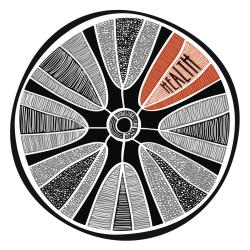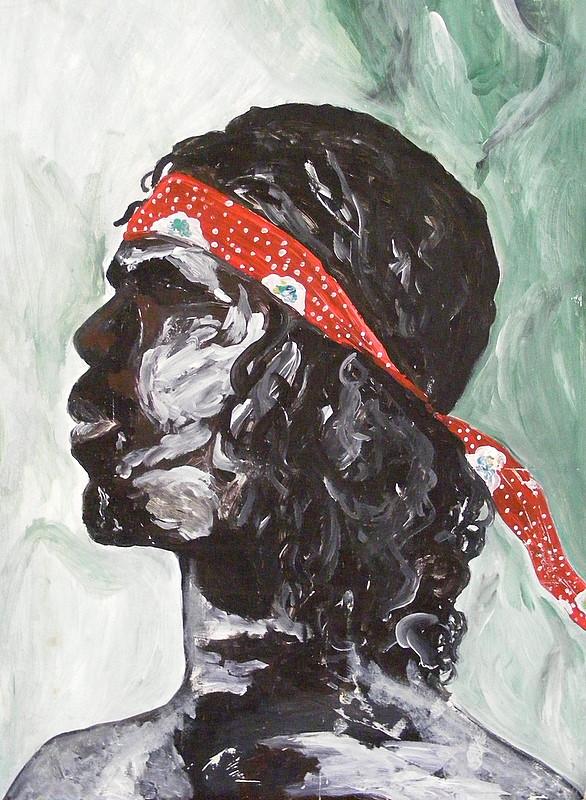Health, social and emotional wellbeing

Artwork by Lucy Simpson, Gaawaa Miyay Designs, gaawaamiyay.co.
Indigenous peoples before colonisation
At the time of first European contact, it is estimated that between 315,000 and 750,000 people lived in Australia, with upper estimates being as high as 1.25 million [1]. A cumulative population of 1.6 billion people has been estimated to have lived in Australia over 70,000 years prior to British colonisation [2].
British settlement in 1788 brought a series of European epidemic diseases such as measles, smallpox (perhaps deliberately [3]) and tuberculosis. In the 19th century, smallpox was the principal cause of death for Indigenous peoples [4]. Direct violence was also perpetrated against Indigenous peoples, resulting in many thousands of deaths.
The 1835 doctrine of Terra Nullius gave further impetus to the mass appropriation of land and water as the whole continent was deemed to be the property of the British Crown. It formally denied the Indigenous population access to resources crucial to sustaining health, social and emotional wellbeing.
Land core to sustainability and health
Land is fundamental to the wellbeing of Aboriginal people. The land is not just soil or rocks or minerals, but a whole environment that sustains and is sustained by people and culture. For Indigenous Australians, the land is the core of all spirituality and this relationship and the spirit of ‘country’ is central to the issues that are important to Indigenous people today.
Connection to land continues. Even when there has been annexation, Indigenous peoples can come back to country and be recognised by country as coming from that geographical place. Land is life, and plays essential role in the well-being of Indigenous Australians; it is an important clue to improving Aboriginal health.
– Professor Juanita Sherwood
Colonisation’s impact on Indigenous health
The combination of disease, loss of land, deliberate poisoning of water holes and direct violence reduced the Aboriginal population by an estimated 90% between 1788 and 1900. Entire communities in the moderately fertile southern part of the continent were wiped out, often before European settlers arrived or recorded their existence.
By the 1920s, the Indigenous population had declined to between 50,000 and 90,000. But, by about 1930, those Indigenous Australians who had survived had acquired better resistance to imported diseases, and birth-rates began to rise again as communities adapted to changed circumstances. In so doing, the first peoples had defied the predictions by health researchers of the early 20th century that Aboriginal Australians were headed for extinction (Mitchell 2007:52 [5]).
In 2006, the Indigenous Australian population stood at around 517,000, or 2.5% of the population (ABS, 2008 [6]). Despite advances, a lot of health services today are not as culturally safe for Indigenous people as for non-Indigenous people, adding to higher levels of disadvantage. Sometimes this is because more Indigenous people live in remote locations and not all health services are offered outside of cities. Sometimes health services are not culturally appropriate; they do not consider Indigenous culture and specific needs. Some Indigenous people may not be able to use some services because they are too expensive.
In response to these issues, the first Aboriginal Medical Service (AMS) was established in Redfern in 1971 and now provides services to around 55,000 patients each year. Following that successful model there are now 198 Aboriginal community-controlled health services in Australia [7] seeking to improve the health standards in Aboriginal communities across the country.
Differences in life expectancy between Indigenous and non-Indigenous peoples in comparative countries
122 – Rank of Aboriginal Australians on the United Nations Index of Human Development (which considers life expectancy, literacy and standard of living).
2 – Rank of all Australians on the United Nations Index of Human Development. 2013, United Nations
In 2009 the Australian Bureau of Statistics estimated life expectancy at 67.2 years for Indigenous men (11.5 years less than for non-Indigenous) and 72.9 years for Indigenous women (9.7 years less than for non-Indigenous). By way of comparison, in New Zealand, Maori life expectancy is about 7 years lower than non-Maori [8]; and in Canada, the differences are 8.1 years and 5.5 years for men and women respectively [9].
The national figures mask greater variations between different parts of Australia. For instance, the estimated life expectancy at birth for Indigenous males in the Northern Territory is 61.5 years and in New South Wales it stands at 69.9 [10]. Also, the data informing the figures is patchy due to the fact that Indigenous persons are often undercounted when recording deaths.
According to the ABS, in 2002 Indigenous Australians were twice as likely to report their health as fair/poor and 1.5 times more likely to have a disability or long-term health condition (after adjusting for demographic structures) than non-Indigenous Australians.
Examples of health differences in Australia
Some of the health problems with the highest disparity in incidence compared with the non-Indigenous population include:
- Circulatory system (2 to 10-fold) – 5 to 10-fold increase in rheumatic heart disease and hypertensive disease, 2-fold increase in other heart disease, 3-fold increase in death from circulatory system disorders. Circulatory system diseases account for 24% of deaths.
- Renal failure (2 to 3-fold) – 2 to 3-fold increase in listing on the dialysis and transplant registry, up to 30-fold increase in end stage renal disease, 8-fold increase in death rates from renal failure, 2.5% of total deaths.
- Communicable (10 to 70-fold) – 10-fold increase in tuberculosis, Hepatitis B and Hepatitis C virus, 20-fold increase in Chlamydia, 40-fold increase in Shigellosis and Syphilis, 70-fold increase in Gonococcal infections.
- Diabetes (3 to 4-fold) – 11% incidence of Type 2 Diabetes in Indigenous Australians, 3% in non-Indigenous population. 18% of total Indigenous peoples’ deaths.
- Cot death (2 to 3-fold) – Over the period 1999–2003, in Queensland, Western Australia, South Australia and the Northern Territory, the national cot death rate for infants was three times the rate.
- Mental health (2 to 5-fold) – 5-fold increase in drug-induced mental disorders, 2-fold increase in diseases such as schizophrenia, 2 to 3-fold increase in suicide (though many suicides are misreported as accidents [11]).
- Optometry/Ophthalmology (2-fold) – A 2-fold increase in cataracts.
- Neoplasms (60% increase in death rate) – 60% increased death rate from neoplasms. In 1999–2003, neoplasms accounted for 17% of all deaths.
- Respiratory (3 to 4-fold) – Accounts for 8% of total deaths.
See the Australian Indigenous HealthInfoNet for a summary and links to more detailed information of Australian Indigenous health issues.
Chapter References
[1] Evans, R. (2007). A History of Queensland. Cambridge UK: Cambridge U. Press. pp. 10–12.
[2] Axelsson, Per; Sköld, Peter, eds. (2011), Indigenous Peoples and Demography: The Complex Relation Between Identity and Statistics, Berghahn Books, Chap.1 “Fractional Identities:..”, Smith, McCalman et al, pp.15-16.
[3] In his 1996 book Claiming a Continent: a new history of Australia, David Day claimed there “remains considerable circumstantial evidence to suggest that officers other than [Governor] Phillip, or perhaps convicts or soldiers … deliberately spread smallpox among [Aboriginal people]”. This apparently copied similar attempted germ warfare by the British, who used infected blankets to pass on the disease to North American Indians during Pontiac’s Rebellion in 1763.
[4] Glynn, Ian; Glynn, Jenifer (2004). The life and death of smallpox. Cambridge University Press. pp. 145–146. ISBN0-521-84542-4.
[5] Mitchell, J. (2007) “History” in Social determinants of Indigenous Health. B. Carson, T. Dunbar, et al. Crows Nest, NSW, Allen & Unwin: 41-64.
[6]“Aboriginal and Torres Strait Islander Population”. 1301.0 – Year Book Australia, 2008. Australian Bureau of Statistics. 7 February 2008.
[7] Visit Better To Know to look for Clinics and Aboriginal Medical Services.
[8] Statistics New Zealand, Retrieved 24 May 2013.
[9] Health Canada. First Nations Comparable Health Indicators. January 2005.. Retrieved 24 May 2013.
[10] Australian Institute of Health and Welfare Canberra. Life expectancy and mortality of Aboriginal and Torres Strait Islander people, May 2011.
[11] Colin Tatz, Aboriginal suicide is different: Aboriginal youth suicide in New South Wales, the Australian Capital Territory and New Zealand: towards a model of explanation and alleviation, Criminology Research Council grant; (25/96-7), 14 July 1999.
Artwork
The connection to land is intrinsic to Aboriginal health and a recurring feature of Aboriginal people’s artwork. Many artworks illustrate country often from a bird’s eye perspective. Country represents belonging, family and physical and spiritual sustenance.
UTS ART Education and Outreach Co-ordinator Alice McAuliffe and academic Jennifer Newman have produced a series of videos that explore the cultural and social contexts of Indigenous artwork from the UTS Art collection.
‘Dreamtime – Machine Time’ by Trevor Nickolls
Trevor Nickolls was called the “father of urban Indigenous art”, and a close look at his work, sheds light on what it meant for him to identify as an Indigenous man born and bred in the city. The work utilises traditional ochre colours, motifs and styles to construct modern symbols of technology and urban living. Trevor considered his work, which pushed back against notions about what constitutes ‘authentic’ Indigenous art, as a means to explore his personal political identity.
Watch the video Trevor Nickolls ‘Dream Time Machine Time’.
‘Dialysis, Homeless, Diabetes’ by Vanessa Inkamala
In her work Dialysis, Homeless, Diabetes, Vanessa Inkamala acknowledges both the artistic heritage of her ancestors (one of whom was Albert Namatjira) and her connection to her country of Ntaria (Hermannsburg). Looking at the painting from certain angles, the three words of the title appear as if by magic, which Vanessa has masterfully applied over the landscape in clear acrylic. The words reveal the reality of living on country for many Indigenous Australians in the 21st century. Through this painting, Vanessa reminds us that despite efforts to maintain traditional links to the land, life has changed for her people as a consequence of colonialism.
Watch the video Vanessa Inkamala ‘Dialysis Homeless Diabetes’.
Additional artwork

Indigenous Man by Jacqui Stewart. Image provided by the artist. jacquistewart.com.au
